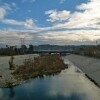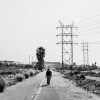Frogtown Without Frogs: The Changing Ecology of the Bowtie Parcel and the L.A. River

Published in partnership with Clockshop, "South of Fletcher: Stories from the Bowtie" looks at Los Angeles’s greatest challenges and opportunities: the housing crisis, lack of open space, effects of climate change, and forces of urban development. This unassuming, seemingly abandoned site along the Los Angeles River pulls everything into focus. The future of the Bowtie Parcel, once one of Southern California’s most important railroad yards, is being discussed right now. "South of Fletcher: Stories from the Bowtie" aims to diversify the voices being heard by listening to the people who know the Bowtie — what it was, what it is, and who care about what it will become.

More on the Bowtie Parcel and the L.A. River
Standing by the edge of the Los Angeles River, in Northeast L.A., you won’t have to go very far back in time to visualize this area when it wasn’t covered in as much concrete as it is now. There was a time when it was home to several animal species and plants — or at least, a time when it was home to more frogs.
Think back just three decades ago. That’s when Liz Vega first noticed the frogs in this area across the river from the Bowtie that is now named after the amphibian: Frogtown.
“I would just be able to go out in the front yard, and on the side of the grass, everywhere, there were frogs,” Liz told us. “Now there are none. It’s sad.”
Locals have stories about finding frogs everywhere on the ground, on their car windshields, and outside their doorsteps. It turns out they were specifically called young western toads and Pacific chorus frogs, and they were as small as two inches long.
Most of the L.A. River’s 51 miles flows through a concrete flood control channel that was built in the 1940s and 1950s, but in this section, next to the Bowtie and Frogtown, the river is very much alive despite the surrounding infrastructure. The frogs may be gone, but there are still willows and tall grasses growing in the riverbed. You can still find common carp and largemouth bass in the water, as well as herons and egrets nesting there.
And on the adjacent Bowtie site, you can find lots of disturbance following plants — species that do well in spite of (or perhaps because of) less-than-ideal living conditions, amidst all the concrete and the lack of space.
Earlier this spring, we invited historical ecologist Travis Longcore of the University of Southern California to the Bowtie. We asked him to guide us through the landscape to help us identify nature where most would pass it over as environmental degradation.
We stood on the asphalt path, looking down past the concrete channel at the river and its vegetation below. It was as if the two landscapes didn’t belong in the same picture. In the foreground, there was gravel and asphalt and trash strewn about. Down in the water, a 30-feet-tall willow tree, with a couple of white egrets resting on its branches.

“You see this here?” Travis asked us, singling out a bush bursting with yellow flowers. “Deerweed is a great butterfly food plant. It’s a native plant of the chaparral and coastal sage scrub, and it thrives here because it’s a disturbed site.” As we walked along the path, we looked around and found coyote brush and mule fat, which Travis referred to as “bulletproof” plants of the river terraces, or old floodplains.
We stood on landfill, on the edge of a concrete channel, thinking about how these disturbance-loving species have been around this area for centuries and will be with us in the future, too.
We could imagine what this place might have looked like 100, 200 or 300 years ago, before the railroad came and built Taylor Yard. We could reach back even farther, before the Spanish arrived in the late-18th century, and the native Tongva people lived off this river’s waters, and the animals and plants it supported.
If we could ignore the freeway buzzing in the distance, and the concrete on the L.A. River channel, we could almost picture this place as it must have been. Images come to mind of rolling hills, clusters of coast live oaks and willow trees next to the river, with frogs and toads hopping around everywhere.
Top Image: The L.A. River is seen from the Bowtie Parcel on a foggy winter morning earlier this year. Here, in what is known as part of the Glendale Narrows, a high water table has allowed for the river’s natural bottom to be preserved, and for diverse plant and animal species to thrive. | Bear Guerra
More photos from this project are on view at Occidental’s Weingart Gallery through November 4, presented by Oxy Arts.
The South of Fletcher podcast is live now. New episodes are released bi-weekly on Clockshop and on Apple Podcasts.













